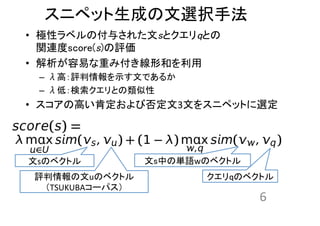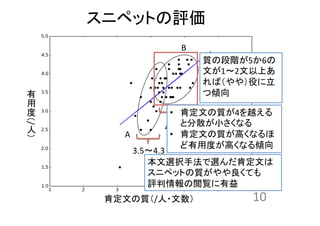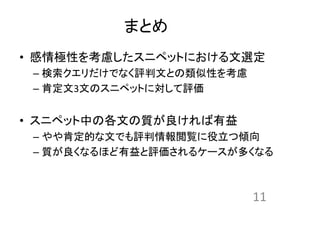感情极性を考虑した検索スニペット生成のための文选択手法
- 1. 感情極性を考慮した検索スニペット の生成のための文選択手法 名古屋工業大学大学院 情報工学専攻 ? 寺澤 友治朗, ? 白松 俊,大囿 忠親,新谷 虎松 1 ?
- 2. 本研究の目的 ?? 感情極性を考慮した検索スニペットの提示 ? ?? Yujiro ?et ?al. ?2015 ? ?? 検索対象の評判情報の閲覧を支援 ? ?? 評判情報には必要な情報が含まれる ?? 感情極性(肯定?否定的表現)を含む傾向 ? ?? 検索スニペット(スニペット)に着目 ? ??検索エンジンで出力されるウェブ文書の抜粋 ? ?? ウェブ文書中の多数の文から数文選択して提示 ? Sen3ment ?Polarity ?Analysis ?for ?Genera3ng ?Search ?Result ?Snippets ?based ? on ?Paragraph ?Vector, ?Yujiro ?Terazawa, ?Shun ?Shiramatsu, ?Tadachika ?Ozono ? and ?Toramatsu ?Shintani, ?Proc. ?of ?4th ?Interna3onal ?Congress ?on ?Advanced ? Applied ?Informa3cs ?2015, ?pp.109-?‐114, ?2015. ? 2 ?
- 3. 関連研究 ?? Aula ?et ?al. ?2010 ? ??特定トピックに関するウェブ文書の推測に有効な プレビューの研究 ? ??テキストのスニペット+スクリーンショットが予想 どおりの情報を与える ? ?? テキストのみだと過大評価してしまう ? ??本研究では評判情報の閲覧の支援に着目 ? ?? 肯定文?否定文の提示 ? Aula, ?A., ?Khan ?, ?R. ?M., ?Guan ?, ?Z., ?Fontes ?, ?P., ?& ?Hong, ?P. ?(2010). ? A ?comparison ?of ?visual ?and ?textual ?page ?previews ?in ?judging ? the ?helpfulness ?of ?web ?pages. ?In ?Proceedings ?of ?the ?19th ? interna3onal ?conference ?on ?World ?wide ?web. ?pp. ?51-?‐60. 3 ?
- 4. クエリ Google スニペット生成の ための文選択 検索結果 ? サーバーサイド クライアント ? サイド ユーザー 入力 出力 システム概要 感情極性分析 4 ? メインコンテンツ 抽出 検索結果取得 スニペットの生成
- 5. 識別器の設定と評価 5 ? Paragraph ?Vector ?[Le ?2014] ?? 旅行関連のデータの文 ? ?? 2,060,255文 ? ?? 階層ソフトマックス ? を用いて学習 ? 多重ロジスティック回帰分析 ?? L1正則化 ? ?? パラメータ ?α ?= ?1.0 ? TSUKUBA ?コーパス ?4,309文 ? ?? 極性ラベル付き ?? データセットを7:1に分けた,ブートストラップによる評価 ? ?? 肯定文のみのスニペットを考察 ? Le, ?Q. ?V., ?& ?Mikolov, ?T. ?(2014). ?Distributed ?Representa3ons ?of ?Sentences ?and ?Documents. ? Proceedings ?of ?The ?31st ?Interna3onal ?Conference ?on ?Machine ?Learning, ?pp. ?1188–1196 ?? 文選択の前に肯定文と否定文の識別 ? ?? 株式会社楽天が提供する楽天データを使用 ? ?? 旅行先のレビューや極性ラベル付きの文含む ? 褒め ? 苦情,要求 ? ニュートラル ? 肯定的 ? 否定的 ? 識別不能 ? 楽天公開データ: ?hhp://rit.rakuten.co.jp/opendataj.html ? TSUKUBAコーパス: ?hhp://www.nlp.mibel.cs.tsukuba.ac.jp/~inui/SA/corpus/ ? 検証したラベル 識別制度 肯定的 93.9% 否定的 67.4%
- 6. スニペット生成の文選択手法 ?? 極性ラベルの付与された文sとクエリqとの? 関連度score(s)の評価 ? ?? 解析が容易な重み付き線形和を利用 ?? λ高:評判情報を示す文であるか ? ?? λ低:検索クエリとの類似性 ? ?? スコアの高い肯定および否定文3文をスニペットに選定 ? クエリqのベクトル 文s中の単語wのベクトル 文sのベクトル 評判情報の文uのベクトル ? (TSUKUBAコーパス) 6 ?
- 7. デモムービー 7 ?
- 8. 式score(s)のパラメータの検討 λ 選定された文 0.0 温泉ガイドのご利用方法 30 ?軒ありました 6つのお風呂全てが貸切で温泉三昧 0.5 2人で、無料の貸切露天?飛騨牛付き? ? のんびりカップルプラン またイワナの骨酒もオススメ! ? 焼岳をバックに、穂高、槍ヶ岳などを一望できる ? 最高のロケーション 8 ? ?? 「新穂高温泉」で検索したうちの、上位のウェブ文書 ? ?? 肯定的な文で、スコア上位3つ ? ?? 『評判情報であるか』を考慮したほうが ? 誤識別された文が減る クエリ中の ? 『温泉』に反応 ? 評判情報に反応 ?
- 9. スニペットの評価 ?? 評判情報の閲覧に有用かを ? アンケート評価 ? ?? 20代男性8人に50件の ? スニペットを評価 ? ?? 肯定文3文のスニペット ? ?? 以下の質問に回答 ? ?? ?有用度 ? ?? ?スニペット中の各文の質 ??score(s)のパラメータ λ ?= ?0.5 ? 段階 スニペットの文の質 1 肯定的ではない 2 3ほど肯定的ではない 3 あまり肯定的ではない 4 わからない 5 やや肯定的である 6 5よりも肯定的である 7 肯定的である 段階 有用度 1 役に立たない 2 あまり役に立たない 3 どちらでもない 4 少し役に立つ 5 役に立つ 9 ?
- 10. スニペットの評価 肯定文の質(/人?文数) 有 用 度 (/ 人 ) A B 10 ? 3.5?4.3 4.3以上 ?? 肯定文の質が4を越える と分散が小さくなる ? ?? 肯定文の質が高くなるほ ど有用度が高くなる傾向 ? 本文選択手法で選んだ肯定文は ? スニペットの質がやや良くても ? 評判情報の閲覧に有益 ? 質の段階が5か6の 文が1?2文以上あ れば(やや)役に立 つ傾向 ?
- 11. まとめ ?? 感情極性を考慮したスニペットにおける文選定 ? ??検索クエリだけでなく評判文との類似性を考慮 ? ??肯定文3文のスニペットに対して評価 ? ? ?? スニペット中の各文の質が良ければ有益 ? ??やや肯定的な文でも評判情報閲覧に役立つ傾向 ? ??質が良くなるほど有益と評価されるケースが多くなる ? 11 ?


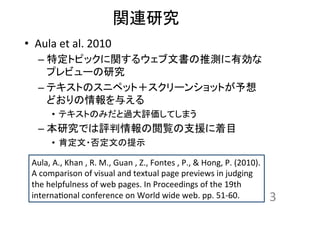
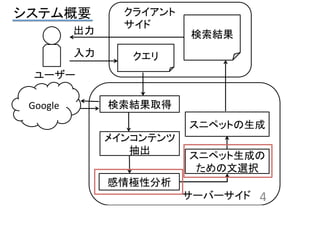
![識別器の設定と評価
5
?
Paragraph
?Vector
?[Le
?2014]
?? 旅行関連のデータの文
?
?? 2,060,255文
?
?? 階層ソフトマックス
?
を用いて学習
?
多重ロジスティック回帰分析
?? L1正則化
?
?? パラメータ
?α
?=
?1.0
?
TSUKUBA
?コーパス
?4,309文
?
?? 極性ラベル付き
?? データセットを7:1に分けた,ブートストラップによる評価
?
?? 肯定文のみのスニペットを考察
?
Le,
?Q.
?V.,
?&
?Mikolov,
?T.
?(2014).
?Distributed
?Representa3ons
?of
?Sentences
?and
?Documents.
?
Proceedings
?of
?The
?31st
?Interna3onal
?Conference
?on
?Machine
?Learning,
?pp.
?1188–1196
?? 文選択の前に肯定文と否定文の識別
?
?? 株式会社楽天が提供する楽天データを使用
?
?? 旅行先のレビューや極性ラベル付きの文含む
?
褒め
?
苦情,要求
?
ニュートラル
?
肯定的
?
否定的
?
識別不能
?
楽天公開データ:
?hhp://rit.rakuten.co.jp/opendataj.html
?
TSUKUBAコーパス:
?hhp://www.nlp.mibel.cs.tsukuba.ac.jp/~inui/SA/corpus/
?
検証したラベル
識別制度
肯定的
93.9%
否定的
67.4%](https://image.slidesharecdn.com/terazawatokai150928-160125034248/85/-5-320.jpg)
